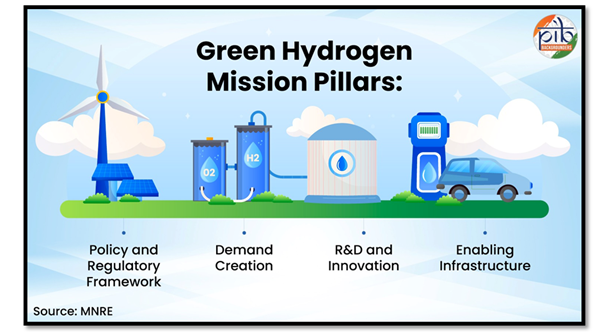Introduction
India’s energy transition has entered a decisive phase as the country shifts from fossil fuels toward clean, domestically produced energy sources. Green Hydrogen has emerged as a strategic fuel capable of decarbonising hard-to-abate sectors such as fertilisers, steel, refining, heavy mobility and shipping. This also supports national priorities of Net Zero by 2070 and making India a developed nation by 2047.
What is Green Hydrogen?
Green Hydrogen is hydrogen produced using renewable energy (solar, wind) where water is split into hydrogen and oxygen through electrolysis. Under the Government of India’s standard, the hydrogen produced can be called “green” only if total emissions in the entire process are extremely low (≤ 2 kg CO₂ equivalent per 1 kg hydrogen).

National Green Hydrogen Mission (NGHM)
Launched in 2023, NGHM is India’s umbrella programme to build the hydrogen ecosystem, scale production, incentivise electrolyser manufacturing, support R&D, and develop demand in industries and mobility. The mission aims to position India as a global hub for Green Hydrogen and green derivatives such as Green Ammonia and Green Methanol.
Mission Targets (by 2030)
-
- Produce 5 million metric tonnes (MMT) of Green Hydrogen every year.
- Add 125 GW of new renewable energy capacity dedicated to hydrogen.
- Attract investments of ₹8 lakh crore+.
- Reduce fossil fuel imports by ₹1 lakh crore+.
- Create 6 lakh jobs.
- Avoid nearly 50 million metric tonnes of CO₂ emissions every year.
Mission Outlay (Funding Structure)
Total outlay till FY 2029–30: ₹19,744 crore
| Mission Component | Allocation |
|---|---|
| SIGHT Scheme (Production + Electrolysers Incentives) | ₹17,490 crore |
| Pilot Projects | ₹1,466 crore |
| Research & Development | ₹400 crore |
| Other Components | ₹388 crore |
Key Implementation Schemes
1. SIGHT (Strategic Interventions for Green Hydrogen Transition)
Largest incentive scheme under NGHM, promoting domestic manufacturing of electrolysers and incentivising Green Hydrogen production.
2. Green Hydrogen Hubs (Port-led Development)
Three major ports notified as Hydrogen Hubs to enable production, storage, bunkering, and export:
-
- Deendayal Port (Gujarat)
- V.O. Chidambaranar Port (Tamil Nadu)
- Paradip Port (Odisha)
India’s first port-based Green Hydrogen pilot project has been commissioned at V.O. Chidambaranar Port.
3. Green Hydrogen Certification Scheme (GHCI)
Introduced to ensure traceability, emission accounting, and certification. Only hydrogen that meets emission standards can be officially labelled “Green Hydrogen.”
4. SHIP (Strategic Hydrogen Innovation Partnership)
A public–private R&D partnership with national scientific institutions (BARC, ISRO, CSIR, IITs, IISc). Funding includes a dedicated R&D corpus plus a ₹100 crore innovation fund to support hydrogen start-ups.
Where Hydrogen Is Being Used
Industrial
-
- Fertilisers: First long-term tender issued for Green Ammonia supply (7.24 lakh tonnes annually).
- Refineries: Gradual transition from fossil-based hydrogen to Green Hydrogen.
- Steel: Five pilot projects launched to test hydrogen-based steelmaking in Indian industrial conditions.
Mobility and Transport
-
- Hydrogen vehicle pilots:
- 37 hydrogen vehicles (fuel cell + H₂ internal combustion engines)
- 9 hydrogen refuelling stations
- Across 10 pilot routes
- Shipping and Ports:
- Port-based hydrogen production and bunkering facilities
- Start of a Coastal Green Shipping Corridor between Kandla and Tuticorin
- High-altitude mobility (Leh):
- World’s highest Green Hydrogen mobility project (3650 m altitude)
- Includes hydrogen buses and a refuelling station
- Hydrogen vehicle pilots:
Global Hydrogen Diplomacy
India has built strong partnerships to position itself as an export player:
| Partner Country / Platform | Nature of Collaboration |
|---|---|
| European Union (EU–India TTC) | Joint proposals for R&D and hydrogen-from-waste |
| United Kingdom (UK) | Standardisation and harmonising global hydrogen codes |
| Germany (H2Global) | Export market development through tender-linked mechanism |
| Singapore (Sembcorp) | Integrated green hydrogen and ammonia export hubs |
India showcased its first Hydrogen Pavilion at the World Hydrogen Summit in Rotterdam, signalling its global positioning.
Challenges
1. Even with early tenders, green molecules remain costlier.
2. GHCI must align with EU/Japan import rules otherwise exports face friction despite being “green” domestically.
3. Electrolysis needs significant process water, siting in arid belts risks local stress. Also, electrolysers need high-quality DC power.
4. Rapid scale-up needs standardised handling, port protocols, emergency response, and trained workforce at hubs and along corridors.
5. Government itself cautions that 5 MMT may slip to 2032 & export-market uncertainty and slow global demand creation could delay projects.
How to Overcome These Challenges
-
- Contracts-for-Difference (CfDs) and multi-year offtake for fertilisers/refining/steel to bridge green–grey price gaps; staggered use-mandates (e.g., % green inputs) as supply matures.
-
- Fast-track electrolyser indigenisation (AEM/alkaline/PEM stacks and BOP), concessional green credit lines, and 24×7 RE with storage to ensure truly green electrons.
-
- Align India’s MRV with EU RFNBO and other import standards & publish facility-level emissions data and third-party audit trails to build buyer confidence quoted by MNRE
- As per ORF there needs to be National Hydrogen Skills Framework (operators, inspectors, first responders) & mandatory safety case and emergency drills for plants and ports.
Conclusion
Therefore, to next jump requires bankable demand instruments, cheap 24×7 green power, export-grade certification, water-smart siting, and safety-ready ports.
Spread the Word
